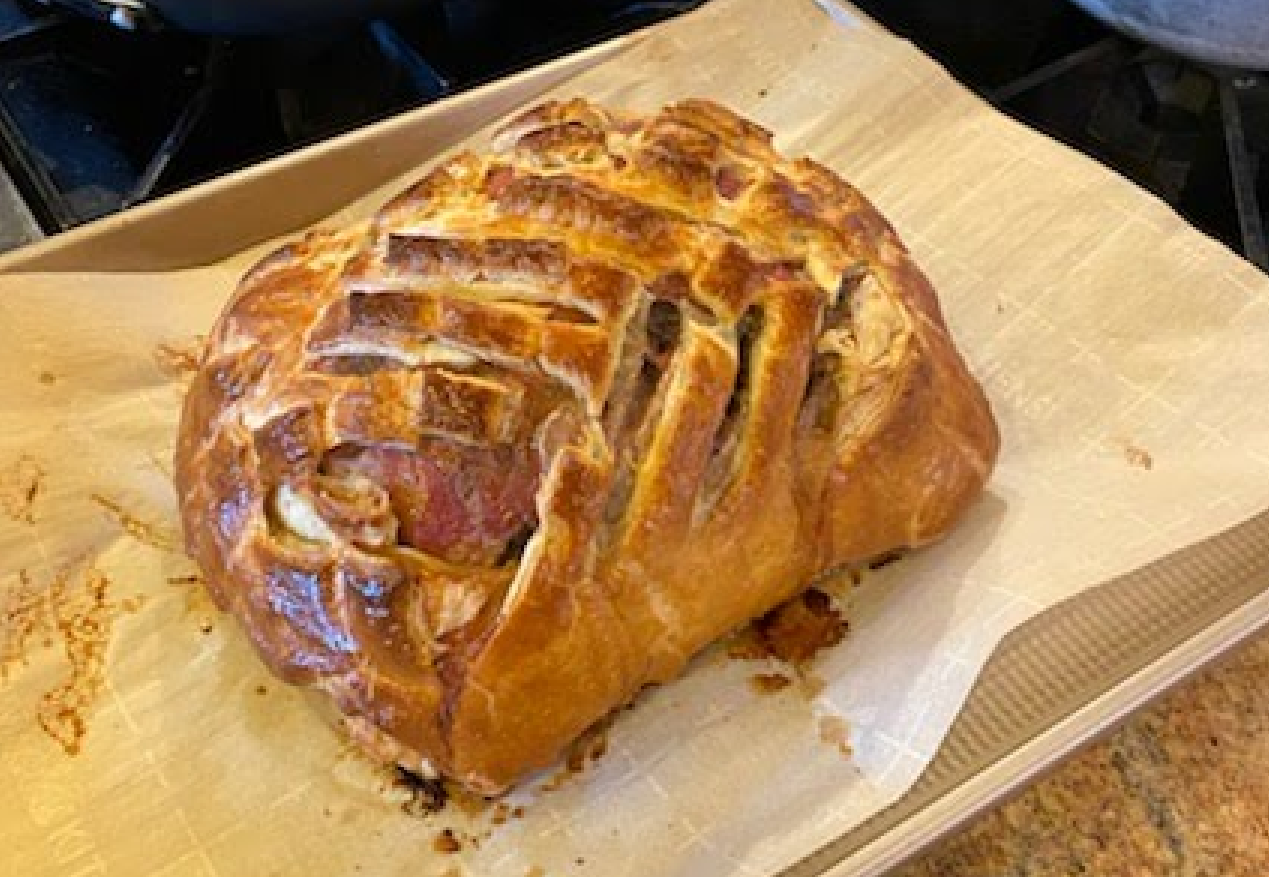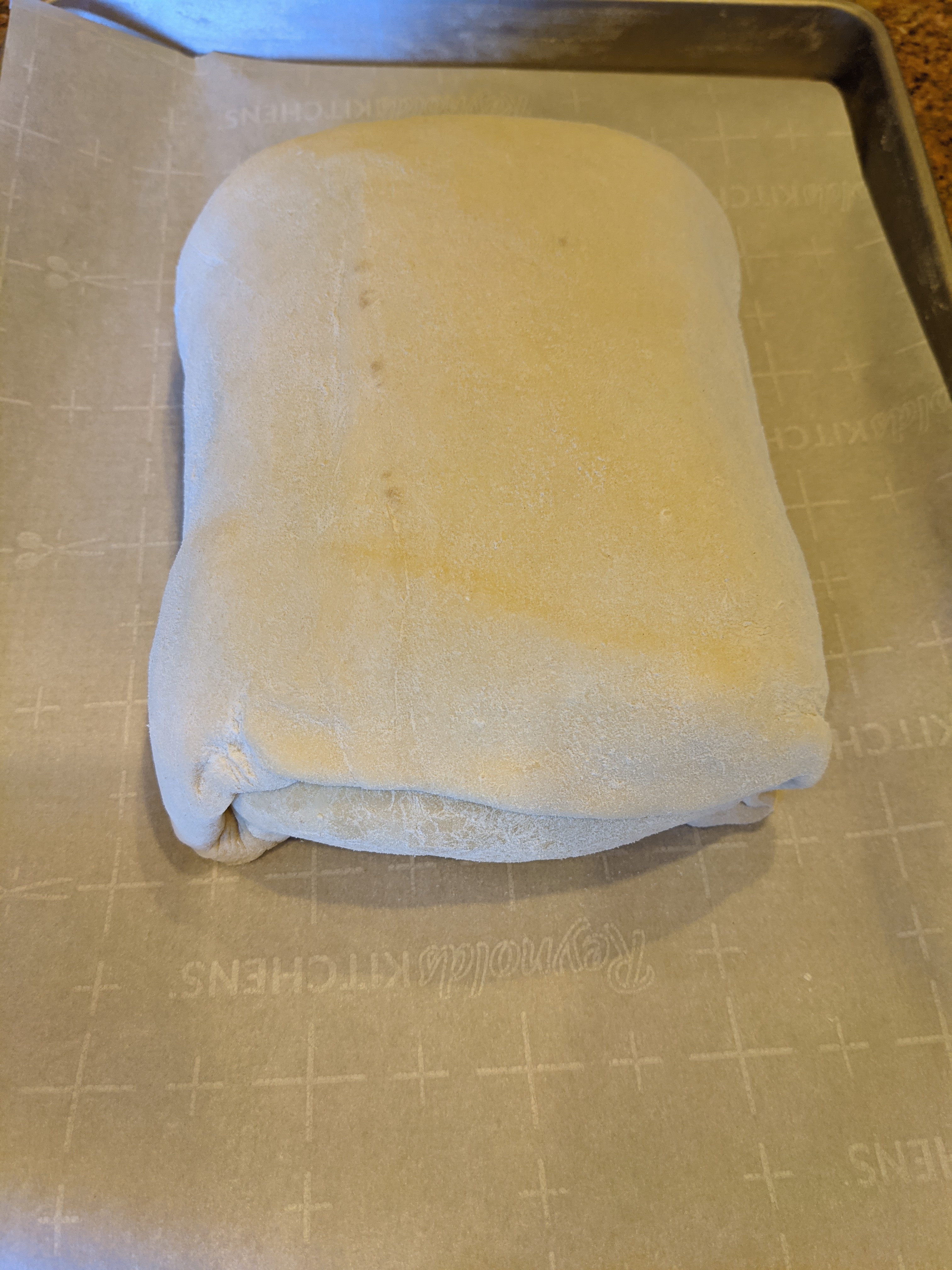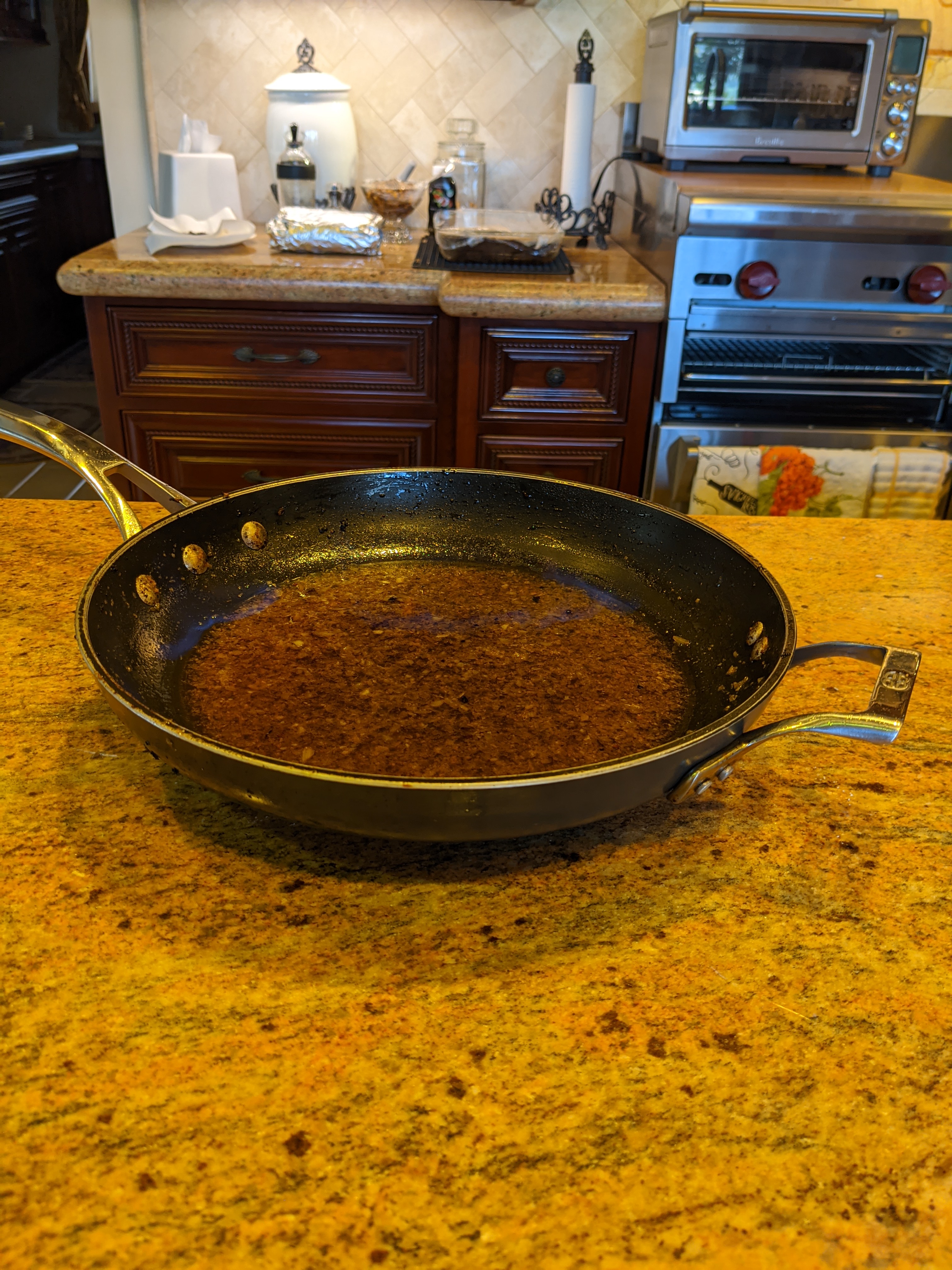Wellington of Beef Tenderloin with Red-Wine Reduction Sauce and Creamy Green Peppercorn Brandy Sauce
Description
It is generally agreed that Beef Wellington was created in celebration of the first Duke of Wellington, Arthur Wellesley, and his victory at the Battle of Waterloo on June 18th, 1815. The Duke was given his title after defeating Napoleon Bonaparte the year before, and not long after that he became the English Prime Minister. For such an iconic character, they name a pastry-ensconced beef dish after him. The Beef Wellington resembles the French filet de boeuf en croute and may have been renamed the Beef Wellington after the Battle of Waterloo, and includes a wonderful mushroom Duxelles. Duxelles was created by the 17th-century French chef François Pierre La Varenne (1615–1678) and was named after his employer, Nicolas Chalon du Blé, Marquis d'Uxelles. This is an amazing and very impressive dish that is certain to amaze your guests!! We enjoy serving this after a nice Caprese Salad with a Flair / Insalata Caprese along with a wonderful Potato Cake / Gattò Di Patate and Asparagus Spears and Pine-Nuts. (You can access each of these recipes easily by clicking on those recipe titles.)
At a Glance
Equipment
It is important to have a food processor available to make the mushroom Duxelles for this recipe.
Ingredients
For the Beef:
3 pounds of Center-cut, Beef Tenderloin (fillet mignon), trimmed of fat
3 tablespoons of Extra-Virgin Olive Oil
1 tablespoon of Montreal Steak Seasoning
10-12 thin slices of Prosciutto
2 Eggs, lightly beaten
1 pound of Puff Pastry, defrosted if you are using frozen
2 tablespoons of All-Purpose Flour
2 tablespoons of Dijon Mustard (Country-Style)
Kosher Salt, to taste
For the Duxelles (Mushroom Paste):
1 ½ pounds of mixed Mushrooms – an equal mixture of Oyster, Cremini, Shitake, Portobello, and White mushrooms, very finely chopped
1 tablespoon of fresh Thyme leaves, finely chopped
3 tablespoons of Butter
5 cloves of Garlic, minced
¼ cup of White Onion, finely chopped
Quarter of a Fennel Bulb, very finely chopped
1 Shallot, finely chopped
½ tablespoon of Montreal Steak Seasoning
For the Creamy Green Peppercorn Sauce:
1 tablespoon of Butter
1 Shallot, finely chopped
½ teaspoon of Thyme leaves, finely chopped
1 clove of Garlic, minced
2 tablespoons of Beef Demi-Glace
3 tablespoons Green Peppercorns in Brine
1 cup of Beef Broth
⅓ cup of Brandy
½ cup of Heavy Whipping Cream
2 teaspoons of Dijon Mustard (Country-style)
For the Red Wine Reduction Sauce:
1 large Shallot minced
1 large Garlic Clove, minced
½ teaspoon of fresh Thyme leaves, finely chopped
1 cup of dry Red Wine
1 cup of Beef Broth
2 tablespoons of Beef Demi-Glace
2 tablespoons of Butter
Directions
To Prepare the Beef Wellington:
Trim any fat off the Beef Tenderloin (fillet mignon) and tie the Beef Tenderloin tightly with kitchen twine with three loops around the cylinder and then one tie lengthwise. The purpose of the twine is to make sure that the beef stays together when you sear it. In a skillet, heat the 3 tablespoons of the extra-virgin olive oil until the oil is shimmering. Sprinkle a tablespoon of the Montreal Seasoning over the entire tenderloin, and then sear the tenderloin on all sides until it is browned, which should take around 5 minutes. Set the seared beef tenderloin aside.
Reduce the heat of the skillet (and remove any blackened pieces from the skillet, then use the same pan to make the mushroom Duxelles. Add the 3 tablespoons of butter to the skillet, and add the garlic, the onion, the fennel, and the shallots. Stir them and let them cook until they are translucent. Add the mushrooms and sprinkle it with Montreal Steak seasoning and the finely chopped thyme. Cook all of it until the mushrooms are fully cooked, which should be about 10 minutes. Remove the Duxelles from the heat and let it cool. Once it is cooled, process it through a food processor to create a smooth paste.
Lay out a long piece of plastic wrap (about 2 feet long). Leave about 3-4 inches of plastic wrap extra on the length of the long piece of plastic wrap, and a couple of inches on each side of the width of it. Layer the prosciutto slices on top of the plastic wrap -- slightly overlapping each slice of prosciutto on top of the other. Once the mushroom Duxelles has cooled completely, spread it on top of the prosciutto. Make sure to spread a consistent, thin layer of the mushroom Duxelles. If there is left over Duxelles, you can save this and use it for in a risotto or for a ravioli. Don’t use too much mushroom Duxelles -- just a nice thin layer.
Cut the twine off the tenderloin and spread the 2 tablespoons of Dijon mustard over the fillet mignon tenderloin. Place the beef tenderloin at the end of the prosciutto and the mushroom Duxelles. Roll up and wrap the beef tenderloin completely into the plastic wrap/prosciutto/duxelles. Note that the prosciutto should stick out a bit on the ends and then be tucked in completely to cover the tenderloin and duxelles. Tuck in the sides of the plastic wrap, and make sure that it is wrapped tightly. Chill it in the refrigerator for at least an hour to set up so it maintains its shape.
Heat the oven to 450 degrees F. Flour a flat surface and roll out the puff pastry to about ¼-inch thickness. It is important that the puff pastry is long enough and wide enough to fully cover the tenderloin. You do not want too much or your will end up with a lot of extra pastry. It is important that the puff pastry can wrap completely around the tenderloin and be tucked in on the sides. You can use two pieces of puff pastry, if it is necessary, and then use the beaten egg and brush it on the edge to seal the two pieces together. If you use a second sheet of puff pastry, cut it to the length that you need so that you only use as much as you need to wrap around the tenderloin neatly. Take the beef tenderloin out of the plastic wrap and gently wrap it into the puff pastry. Roll up the puff pastry around the beef tenderloin and use the beaten-egg mixture to seal all of the edges. Using a serrated knife, gently score the top of the Beef Wellington to allow the steam to escape. Brush the top of the Beef Wellington with the remaining egg mixture, sprinkle some Kosher salt on top, and then put the Beef Wellington on a sheet pan that has a piece of parchment paper on it and put it into the oven. Cook it for 45 minutes and then remove from the oven and let the Beef Wellington rest for about 15 minutes. While the Beef Wellington is cooking, make the two sauces.
To Prepare the Green Peppercorn Sauce:
Heat a sauté pan on the stove and add the 1 tablespoon of butter. Once the butter has started to melt, add the shallot, garlic and the thyme. Once the shallot and garlic have become translucent, remove the sauté pan from the stove and add the brandy. Light the mixture with a very long match (far away from the stove), and let the brandy alcohol burn off completely.
Once the alcohol has burned off and the flame is gone, return it to the stove heat, and add the demi-glace and the beef broth. Let the sauce cook until it reduces down. Then run the liquid through a fine strainer to remove all of the solids and add the ½ cup of heavy cream and 2 teaspoons of Dijon mustard. Heat it again and after the liquid has reduced, add the green peppercorns, and cook it for another 2-3 minutes. Put into a serving dish and serve warm with the Beef Wellington.
To Prepare the Red-Wine Reduction Sauce:
In a saucepan, add 1 tablespoon of butter and heat until the butter it is melted. Add the shallot and the garlic and cook it until it is translucent. Add the thyme and continue cooking it for another minute. Then add the 1 cup of dry red wine, 1 cup of beef broth, 2 tablespoons beef demi-glace, and let them reduce. Remove the sauce from the heat and strain the sauce of the solids. Return the sauce to the saucepan and return it to a medium heat. Stir the remaining butter into the sauce, and once it is incorporated, pour the sauce into a serving dish, and serve it along-side the Beef Wellington.
Once the Beef Wellington has rested, cut it and serve it on a serving tray along with the two sauces.











